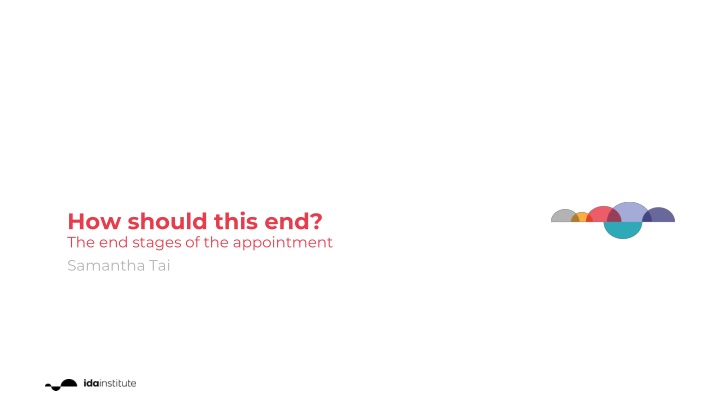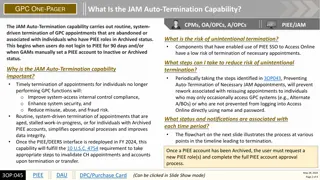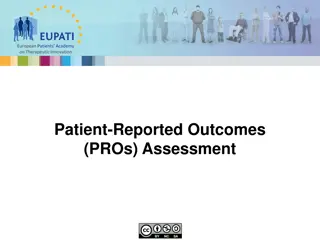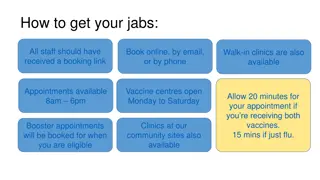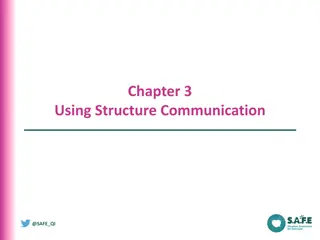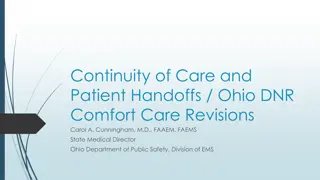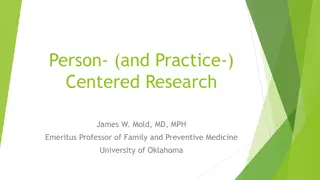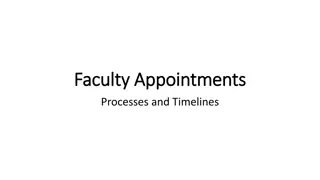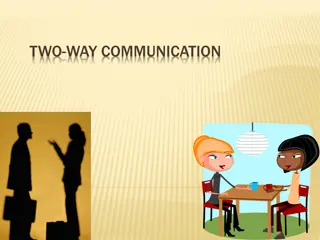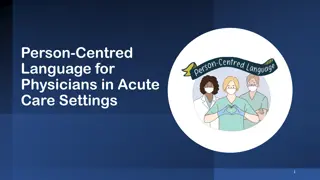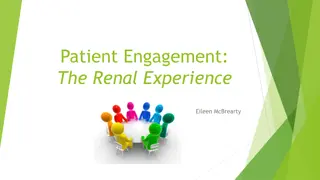Enhancing Communication in Audiologic Appointments: A Patient-Centered Approach
This content discusses the importance of communication during the end stages of audiologic appointments to improve patient outcomes. It emphasizes key communication tasks like diagnosis, decision-making, and closing visits. The dialogue between an audiologist and a patient, along with learning objectives and the Calgary-Cambridge guides, provides insights into creating a safe peer-learning environment and delivering audiologic information effectively.
Download Presentation

Please find below an Image/Link to download the presentation.
The content on the website is provided AS IS for your information and personal use only. It may not be sold, licensed, or shared on other websites without obtaining consent from the author.If you encounter any issues during the download, it is possible that the publisher has removed the file from their server.
You are allowed to download the files provided on this website for personal or commercial use, subject to the condition that they are used lawfully. All files are the property of their respective owners.
The content on the website is provided AS IS for your information and personal use only. It may not be sold, licensed, or shared on other websites without obtaining consent from the author.
E N D
Presentation Transcript
How should this end? The end stages of the appointment Samantha Tai
Learning objectives Overview of today s goals #01 To understand how the clinician s communication can influence patient outcomes at the end stages of the appointment. To introduce the key communication tasks (diagnosis, decision-making, closing the visit) during the end stages to facilitate person-centred interactions. #02 To create a safe peer-learning environment to practice communication skills and offer descriptive feedback. #03 2
Calgary-Cambridge guides Kurtz, S., Silverman, J., Bensons, J. Draper, J.(2005). Marrying content and process in clinical method teaching: Enhancing the Calgary-Cambridge Guides. Academic Medicine,78(8),802-809. 3
Are we too technically focused? Missed patient s emotional concerns Biometrical tendencies Verbal dominance Audiometric results 4
Example Audiologist: So, this is a picture of your hearing. We tested the very low- pitched sounds and the very high-pitched sounds. The blue crosses is the left ear and the red circles is the right ear. You can already see there is a difference between your ears. Your left ear is within the normal range of hearing, but the right ear is what we call a moderate loss . Sophie: Yes, the right ear feels very blocked. Audiologist : Yeah, when we did the speech test, we had to turn the volume up on the right for you to hear the speech sounds. Sophie: So what caused this hearing loss? Audiologist : When we did the pressure test , it showed that the right eardrum isn t moving very well and there may be some fluid. Sophie: What does that mean? Will it recover? Audiologist : Yes, often if you get a cold, the eustachian tube can block up and cause a hearing loss. It may take a few weeks for it to clear up. Sophie: So what can I do about it?! Ms. Sophie Waters, 36-year-old financial advisor was referred for a hearing assessment as her right ear has been feeling blocked. She is concerned about her hearing as it started a week ago and seemed to have progressively gotten worse. Below is the dialogue with her audiologist after the hearing assessment is completed. 5
Invest in the end Benefits Tasks i. Delivering (audiologic) information: e.g. diagnosis of hearing loss, problems with the hearing aids, factors contributing to tinnitus Improve patient recall and understanding Adherence with recommendations Patient satisfaction i. Providing education and joint decision-making i. Closing the visit 6
Deliver diagnostic information Prior to delivering any audiologic information, think about what your patients want to know? What is the cause? What can they do about it? Consider patient s emotions! Use appropriate verbal and non-verbal cues Avoid jargon. Use simple and concise statements. 7
What is jargon to our patients? Audiogram Axis Bone conductor Cochlear Decibels High/low frequency Kilohertz Meniere s disease Middle ear Speech discrimination Advanced directional microphone Channels Compression Dynamic range Feedback canceller Fine tuning Noise reduction Foam block/impressions Induction loop Mould Program button Reshell Signal-to-noise ratio 8
Example phrases Examples of how we can tailor the information back to patient s initial concern(s): Re-state initial concern e.g. You mentioned earlier about noticing a drop in hearing, the results today showed... Check information needs e.g. Are you interested to know the technical details of each tests or just the main points? What do you know about this condition? 9
Involve patients in making decision Outline recommen ded options and rationale Valuing patients preferences and opinions Check for patient understand ing Assessing patients readiness for change Seek any potential barriers Shared decision making 10
Example phrases Examples of communication tasks: Outline recommended options and rationale behind it e.g. I want to go through the management options with you and why I have chosen these. The two options are Check for patient understanding e.g. Does everything make sense so far? Valuing patient s preferences and opinions e.g. How do you feel about these options? Seek any potential barriers e.g. Is there anything that may prevent you from taking this recommendation Assessing patients readiness for change can help orientate the correct recommendation e.g. Are you open to the idea of hearing aids? 11
Complete the visit Three key communication tasks Invite additional information Confirming next steps End on a personal note 12
Example phrases Three key communication tasks i. Invite additional information e.g. Do you have any questions about what we ve discussed? ii. Confirming next steps e.g. To summarize, once you have seen the Ear, Nose, and Throat specialist and have gotten clearance for hearing aids, we will begin the hearing aid trial. The ear specialist will know how best to stop the recurrent ear infections. iii. End on a personal note e.g. Enjoy your holiday to Bali. 13
Role-play activity Groups of three: audiologist, patient and observer Tips: Create information chunks Tailor the diagnosis back to the patient s main concern(s) Use simple and concise statements and avoid jargon Use appropriate verbal and non-verbal cues Use signposting to help structure the appointment Remember to check your patient s understanding 14
Feedback promts Areas to Improve Amazing! Good Clinician frames diagnostic and other relevant information in ways that reflect patient s initial presentation of concerns. Clinician frames diagnosis and information in terms that fit the clinician s frame of reference rather than incorporating those of the patient. Clinician makes cursory attempt to frame diagnosis and information in terms of patient s concerns. Clinician gives information and continues on quickly with giving patient opportunity to react (impression is that this information will not be remembered properly or fully appreciated by the patient). Clinician pauses briefly for patient reaction, but then quickly moves on (leaving the impression that the patient may not have fully absorbed the information). Clinician pauses after giving information with intent of allowing patient to react to and absorb it. Information is stated in ways that are technical or above patient s head (indicating that the patient has probably not understood it fully or properly). Information is stated clearly and with little or no use of jargon. Information contains some jargon and is somewhat difficult to understand. Clinician clearly explains the rationale behind the tests and recommendations so that the patient can understand the significance of these management options. Clinician offers/orders tests and treatments, giving little or any rationale for these. Clinician only briefly explains the rationale for tests and treatments. Clinician makes no effort to determine whether the patient has understood what has been said. Clinician effectively tests for the patient s comprehension. Clinician briefly or ineffectively tests for the patient s comprehension. Adapted from: Krupat, E., Frankel, R., Stein, T., & Irish, J. (2006). The Four Habits Coding Scheme: validation of an instrument to assess clinicians communication behavior. Patient education and counseling, 62(1), 38-45. 15
Feedback promts Areas to Improve Amazing! Good Clinician shows little interest in inviting the patient s involvement in the decision making process, or responds to the patient s attempts to be involved with relatively little enthusiasm. Provider shows no interest in having patient s involvement or actively discourages/ignores patient s efforts to be part of decision making process. Clinician clearly encourages and invites patient s input into the decision making process. Clinician offers recommendations for treatment with little or no attempts to elicit patient s acceptance of (willingness or likelihood of following) the plan. Clinician explores acceptability of treatment plan, expressing willingness to negotiate if necessary. Clinician makes brief attempt to determine acceptability of treatment plan, and moves on quickly. Clinician does not address whether barriers exist for implementation of treatment plan. Clinician fully explores barriers to implementation of treatment plan. Clinician briefly explores barriers to implementation of treatment plan. Clinician makes no attempt to solicit additional questions from patient or largely ignores them if made unsolicited. Clinician allows for additional questions from patient, but does not encourage question asking nor respond to them in much detail. Clinician openly encourages and asks for additional questions from patient (and responds to them in at least some detail). Clinician makes no reference to follow-up plans. Clinician makes clear and specific plans for follow-up to the visit. Clinician makes references to follow-up, but does not make specific plans. Adapted from: Krupat, E., Frankel, R., Stein, T., & Irish, J. (2006). The Four Habits Coding Scheme: validation of an instrument to assess clinicians communication behavior. Patient education and counseling, 62(1), 38-45. 16
Upcoming sessions Unit I: Introduction Invest in the beginning Elicit the patient s perspectives Unit II: Unit III: Demonstrate empathy Unit IV: Invest in the end Unit V: Putting it all together 17
